The Best Types of Evergreen Trees for Wilderness Survival
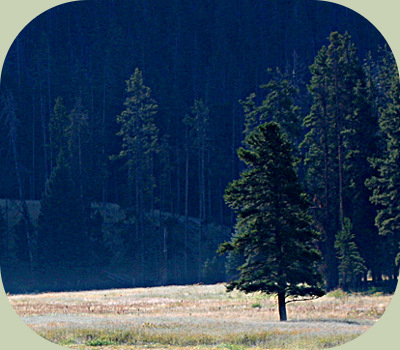
How can you tell the different types of evergreen trees apart and which ones are your best allies in a survival situation? Where are they found and what do they look like?
In the Pacific Northwest we are blessed with a variety of evergreen trees. Three stand out as some of the best for survival purposes. These are species that you will want to get familiar with, so you can count on them if you get into a survival situation.
These three types of evergreen trees also happen to be common and widespread in their preferred habitats and are often found growing together. The types of evergreen trees we are talking about here are Western Red Cedar (Thuja plicata), Douglas fir (Pseudotsuga menziesii) and Western Hemlock(Tsuga heterophylla).
TYPES OF EVERGREEN TREES:
Western Red Cedar (Thuja plicata)
Overall: a statuesque tree which can grow to a incredible size of up to nearly 200 feet tall and with a massive, buttress trunk that can be up to 19 feet in diameter.
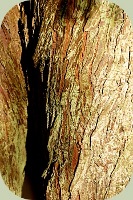
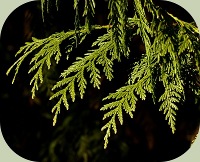
Leaves:The leaves of these types of evergreens are easily distinguished from the needles of other evergreens. They are compressed and scaly, closely hugging the stem. If closely observed, leaves can be seen growing in opposite pairs in 4 rows so that leaves in the first pair are folded, the next pair is not and so on.
Cones: Female cones are small, around half an inch long and formed of 8-12 large scales. The cones stand up on the branches. Male cones are minute, numerous, reddish and found at branch tips.
Habitat: Prefers moist to wet forested moistly in lowlands, but also up to mid-elevation.
Comments:
Known as "the tree of life" by many, this incredible tree has provided a wealth of use to many Native people throughout the Pacific Northwest. Many of the peoples of the coast collected cedar bark in the springtime for many purposes. Cedar bark was then dried, pounded and separated into layers. Then these materials were used to make many different articles including: baskets, ropes, mats, blankets, canoe bailers, and clothing. The wood of red cedar was used to make things that included: dishes, arrow shafts, harpoon shafts, spear poles, barbecuing sticks, fish spreaders and hangers, dipnet hooks, fish clubs, masks, rattles, benches, cradles, coffins and paddles.
Red cedars make amazing tinder bundles for starting fires. Even when it is raining, you can collect the bark and then scrape the inner part of it back and forth with a knife or stone so that it forms a fluffy bundle of fibers. You can then ignite this bundle with a spark, coal or flame. It helps to make this bundle large enough to fill both of your hands. The wood of red cedar is also one of the best and most reliable woods for making friction fires using the bow-and-drill. The spindle, fire board, handhold and a temporary bowline (using a long, thin cedar rootlet) can be created from the wood of this wonderful tree! Hollow bases of standing old-growth trees and old stumps can provide good temporary survival shelters. This tree is arguably the most important of all the types of evergreens to know for survival.
Douglas fir (Psuedotsuga menziesii)
Overall: Potentially a tree of tremendous height, up to 300 plus feet and with a maximum diameter of over 15 feet. Almost matches the coastal redwood (Sequoia sempervirens) as one of the tallest trees in the world! The bark of this tree is very thick, fluted, rough, with ridges and often dark brown.
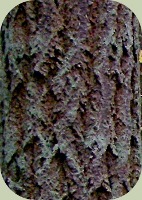
Leaves: Flat needles that are green to yellowish-green, with pointed tips and about 1 inch long. Needles have two pale bands underneath and one groove on the bottom. Needles spirally arranged, though depending on the tree and location may appear more flattened in arrangement when viewed in cross-section. The buds are pointed.
Cones: Female cones 3 to 4 inches in length. Green when young, and at flowering, but browning with age. Scales are papery and overlapping. Papery 3 forked bracts project beyond scales. Can be described as hanging out like the bottoms of trapped mice (hind legs and a tail in between). Male pollen cones are small, reddish-brown at branch ends. The cones on these types of evergreen trees hang downward.
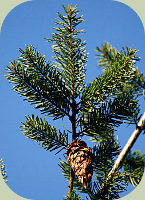
Habitat: Adaptable and found in a variety of locations including extremely dry and low elevation areas to moist mountain zones. Of the 3 types of evergreen trees mentioned here, Douglas firs are the most fire-resistant
Comments: This is an iconic tree of the west coast, found growing among the dry ponderosa pines of the eastern Cascade slopes and many other drier mountain areas. Just as much it is a part of the sopping, wet coastal temperate rainforests where it is often one of the towering giants.
Native peoples used Douglas fir for many things, including: fishhooks, caulking for canoes and water bearing containers, harpoon heads, spear shafts, torches from heartwood, spoons and spear handles. The pitch was used to make healing salves for wounds and skin problems.
The pitch of Douglas fir makes for an excellent asset to have when starting fires. Gather some of the pitch on a stick and carry it with you for easy fire starting with a lighter. The needles make a good, vitamin C-rich tea.
Be More Prepared For Your Next Outdoor Adventure!

Don't leave without knowing these six essential survival skills. Our free survival mini guide reveals the strategies of:
- Shelter & fire to prevent the number one cause of death
- Obtaining clean water to avoid life-threatening dehydration
- Common wild survival foods and other critical skills!

Western Hemlock (Tsuga heterophylla)
Overall: A very tall tree of up to nearly 200 feet, with a fairly narrow crown and often a drooping leader on top. The largest western hemlocks have a diameter at breast height of up to 8 feet. The bark of this tree is scaly, rough, reddish-brown to grayish and furrowed, especially with age.
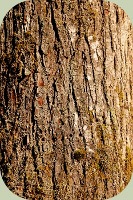
Leaves: The needles are the key to identifying these types of evergreen trees. They are yellowish-green, short, flat, blunted tips, of variable lengths, widely and irregularly spaced. The needles have 2 pale lines underneath.
Cones: The cones are also a useful key to identifying these types of evergreen trees. Males cones are small and numerous. Female cones are also numerous, around 1 inch long, starting out purplish but maturing to a brown. Scales are rounded and papery.
Habitat: Moderately dry to wet areas. This is the most common coniferous tree you will meet in the coastal temperate rainforest. This tree is shade tolerant and also creates a great deal of shade when it matures, to the extent where a dense hemlock forest may have little undergrowth.
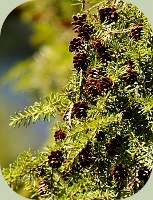
Comments: These types of evergreen trees are a classic part of the Pacific Northwest scenery, whether towering over you in the rainforest or growing as tiny seedlings underfoot. Much of the deep, mysterious shade you experience in the rainforest is provided by these wonderful trees. Hemlocks grow well on humus and decaying wood, and it is a common sight to see lines of hemlock seedlings growing in rows on top of decaying logs. These will eventually straddle the log as they mature.
Native people used hemlock for a number of things, including: wood for spoons, combs, wedges, children’s bows, hemlock-bark solution for tanning, dye for basket materials, and feast bowls. Hemlock branches were seen as a great bedding material, and were also used to collect herring spawn. The pitch was used as salve when mixed with deer tallow to prevent sunburn, made into poultices or poultice coverings.
You can chew young branch tips for short term hunger suppressant. The young growth of these types of evergreen trees contains a fair amount of vitamin C. Western hemlock is another great source of fire materials in survival situations. Because of the density of the foliage, the lowest branches are often shaded out and die back. This leaves very fine, dry materials for very fine kindling. This is especially useful when it is wet and rainy outside and you are struggling to find any dry wood anywhere. Under those conditions, it helps to look for dry wood on the trees, rather than under them.
Evergreens Are Your Friend
Whenever you are exploring the wonderfully lush forest of the Pacific Northwest, remember these types of evergreen trees. They are your best friends and assets, especially in a survival situation. Consider all the many things they provide, from fire and shelter to medicine and tools. Remember to practice good harvesting ethics, and take only what you need and when you need it.
Next time you see any types of evergreen trees, go and introduce yourself. The best way to get to know them is to fully immerse yourself with all of your senses. Feel its needles against your hands and face. Smell them. Run your hands up and down the trunk of the tree. Notice the shape, texture and look of all parts of the tree. Look at the way the light plays on the tree's overall form. Maybe sit under it for a while and enjoy its shade or protection from the wind or rain.
Go out and meet an evergreen tree today!
By the way, when you're out foraging, it's important to know how to stay safe in the outdoors, especially if you were to get lost. Right now you can get a free copy of our mini survival guide here, where you'll discover six key strategies for outdoor emergencies, plus often-overlooked survival tips.
Related Courses:
Learn survival uses of evergreen trees and other wilderness skills at our Wilderness Survival Courses.
Additional resources on identifying types of evergreen trees:
Check out our article on Tree Identification.
The Arbor Day Foundation has an excellent online tree identification key.
Great field guides for trees in North America include:
The Sibley Guide to Trees
The National Wildlife Federation Field Guide to Trees of North America
Plant Technology of First Peoples in British Columbia
Plants of the Pacific Northwest Coast

About the Author: Filip Tkaczyk is a periodic guest teacher at Alderleaf. He also wrote the field guide Tracks & Sign of Reptiles & Amphibians. Learn more about Filip Tkaczyk.
Return from Types of Evergreen Trees to Wild Plants Articles
Is The Essential Wilderness Survival Skills Course Right for You? Take the "Online Survival Training Readiness" Quiz
See for yourself if this eye-opening course is a good fit for you. It takes just a few minutes! Get your Survival Training Readiness Score Now!

Grow Your Outdoor Skills! Get monthly updates on new wilderness skills, upcoming courses, and special opportunities. Join the free Alderleaf eNews and as a welcome gift you'll get a copy of our Mini Survival Guide.

 The Six Keys to Survival: Get a free copy of our survival mini-guide and monthly tips!
The Six Keys to Survival: Get a free copy of our survival mini-guide and monthly tips!
Learn more